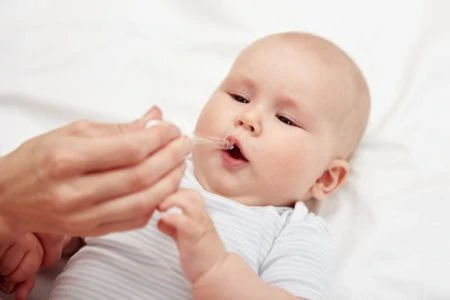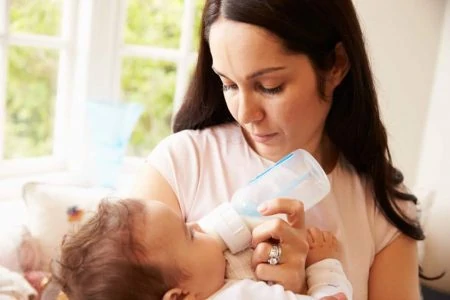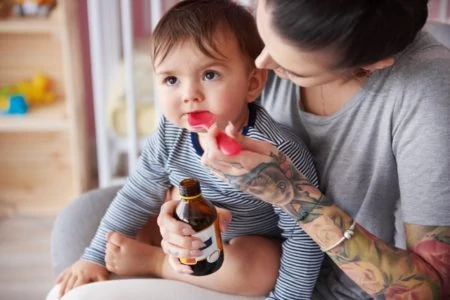Since not all remedies are created equal, we analyzed the top products on the market to find the safest, most effective options. We will break down how they work, what ingredients to avoid, and which drops parents trust most to soothe those tummy troubles.
- Pediatrician approved formula
- Vegan-based ingredients
- Used in conjunction with gripe water
- Free of saccharin, sodium, and dyes
- Berry flavored
- Good option while traveling
How to Choose Baby Gas Drops
The pharmacy aisle is packed with options, and they all claim to be the best. However, ingredients vary significantly between brands. You want something fast-acting, safe, and easy to administer when your baby is fussing.
Here are the most important features to look for in gas relief formulas.
- Simethicone: This is the active ingredient in most effective gas drops. It works by merging small gas bubbles into larger ones, which allows your baby to pass them easily. It is generally safe and not absorbed into the bloodstream, but you should always monitor your baby after the first dose (1).
- User-Friendly Dispensers: Administering liquid to a crying infant is tricky. We prefer squeeze droppers or syringes. These allow you to place the medicine in the side of the cheek to prevent spitting or choking.
These are the ingredients we recommend avoiding:
- Artificial Dyes: Food dyes serve no medical purpose and can stain clothing. Some studies also link them to behavioral side effects in children, so it is best to skip them (2).
- Added Sugar: Some brands add sugar to mask the taste. The AAP recommends avoiding added sugar for children under 2. Look for naturally flavored drops to avoid contributing to gut imbalances.
- Alcohol: While rare in modern baby products, alcohol can still appear in some homeopathic or older formulations. Always double-check the label to ensure the product is 100 percent alcohol-free (3).
Product Reviews
We researched the market to find the safest, fastest-acting relief for your little one.
Mommy's Bliss Gas Relief Drops
Pediatrician Approved Infant Gas Drops
Mommy’s Bliss offers a gentle, pediatrician-approved formula that works quickly.
I appreciate that this company was founded by moms who understand the struggle of a colicky baby. This specific formula uses simethicone to break up gas bubbles effectively.
The ingredients are vegan and include ginger extract, which is known for soothing tummies. Crucially, they leave out the bad stuff. There are no parabens, alcohol, or artificial colors, making it a safe choice for newborns.
The packaging is BPA-free and fully recyclable. The included syringe makes dosing simple, so you do not have to worry about dispensing too much liquid at once.
Pros
- Contains ginger extract.
- Compact bottle for travel.
- Easy-dose syringe included.
- Compatible with gripe water usage.
Cons
- Some babies dislike the flavor.
Our Ratings
Mylicon Infant Gas Relief Drops
Science-Backed Baby Gas Drops
Mylicon is widely recognized as the top brand recommended by pediatricians. Studies show that about three-quarters of babies experience reduced gas symptoms within one day of using these drops (4).
The fruity flavor usually goes down easy with infants. Parents will love that the formula is free from artificial flavors, saccharin, and alcohol. You can safely use these drops at every feeding (up to 12 times a day), which is a lifesaver during cluster feeding.
The syringe makes administration clean and simple. If your baby refuses the syringe, you can easily mix the dose into a bottle of water or formula.
Pros
- Gluten-free formula.
- Safe for use up to 12 times daily.
- Safe for newborns.
Cons
- More expensive than generic alternatives.
Our Ratings
Little Remedies Gas Relief Drops
Best Travel Baby Drops
Little Remedies offers a highly effective product at an affordable price point. Parents and doctors often recommend this brand for its “everything they need, nothing they don’t” philosophy.
These drops work in minutes to relieve tummy pressure and can also help stop hiccups. You can give the dose directly into the cheek or mix it with cool water or formula.
One minor design flaw is that the liquid and the dropper are the same color, which can make measuring in low light difficult. However, a major benefit is that it does not require refrigeration, making it the perfect choice for your diaper bag.
Pros
- No artificial dyes or sodium.
- Pleasant berry flavor.
- Shelf-stable for travel.
Cons
- Contains sucralose and preservatives.
Our Ratings
Equate Gas Relief Drops
Best Value Infant Gas Drops
If you are looking to save money without sacrificing performance, Equate gas drops are a solid generic alternative. They contain the same active ingredient (simethicone) as the leading brands.
The ingredient list is a mix of good and average. It is free from saccharin and alcohol, which is great. However, it does contain benzoate and xanthan gum.
The dye-free formula is a huge plus for parents worried about staining onesies during spit-ups. It gets the job done for a fraction of the cost.
Pros
- Dropper attaches to cap for convenience.
- Mild fruity taste.
- Budget-friendly.
Cons
- Some parents find the consistency thinner than name brands.
Our Ratings
Infacol Colic & Gas Relief Drops
Easy To Use Baby Gas Drops
Infacol is a massive hit in the UK and is available globally. The bottle is larger than most competitors, offering up to 100 doses. Despite the size, it is still small enough to pass airport security liquids checks.
It features a built-in dropper that removes the need for a separate syringe, which simplifies the process significantly. It has an orange flavor that most babies seem to tolerate well.
It is formulated for use from birth onwards, making it a reliable staple for your medicine cabinet.
Pros
- Sugar-free and alcohol-free.
- Cost-effective large bottle.
- No artificial colors.
Cons
- Imported bottles sometimes have seal issues during shipping.
Our Ratings
Why Do Babies Get Gas?
Gassy tummies are most common between four and 12 weeks of age. Your baby’s digestive system is immature, and they gulp down a lot of air.
Here are the main reasons gas builds up.
- Swallowing Air: Whether bottle-feeding or breastfeeding, babies often latch poorly or gulp milk too fast, taking in air with their food.
- Formula Preparation: Shaking a bottle of formula vigorously creates thousands of tiny air bubbles that go straight into your baby’s gut. Swirling the bottle gently is better.
- Crying: It is a vicious cycle. Gas causes pain, pain causes crying, and crying causes the baby to swallow more air.
- Dietary Sensitivities: If you breastfeed, certain foods like broccoli or dairy in your diet might affect your baby. For formula-fed babies, the milk proteins might be difficult to digest.
How Do Gas Drops Work?
The active ingredient is simethicone. It is an anti-foaming agent that does not enter the bloodstream. Instead, it breaks the surface tension of gas bubbles in the stomach. This causes small bubbles to combine into larger ones, which the baby can then pass easily as a burp or a toot (5).
While many parents swear by them, scientific studies on efficacy show mixed results (6).
Are Gas Drops Safe?
Yes, gas drops are considered safe for newborns when used as directed. Simethicone is chemically inert, meaning it passes through the body without being absorbed.
However, you should always consult your pediatrician. Simethicone can interact with thyroid medication (7). You might also notice your baby’s stools becoming slightly looser.
How to Tell If Your Baby Has Gas
Since your baby cannot talk, you have to read their body language.
A fussy baby who clenches their fists or pulls their legs up to their chest is likely in pain. A hard or distended tummy is another clue. If they burp or pass gas and immediately calm down, you know gas was the culprit.
If your baby has a dry diaper, is well-fed, and continues to scream despite passing gas, consult your doctor to rule out other issues like reflux.
Tips for Preventing Gas
Prevention is often the best medicine. Try these techniques to minimize air intake.
- Adjust the Angle: Keep your baby’s head higher than their tummy during feeds. This uses gravity to keep milk down and air up.
- Check the Equipment: Ensure your bottle nipple has the right flow rate. If it is too fast, they gulp air; too slow, and they suck in air while trying to get milk.
- Burp Frequently: Do not wait until the end of the feed. Burp your baby every 2 to 3 ounces or when switching breasts.
- Bicycle Legs: Lay your baby on their back and gently cycle their legs toward their tummy. This manual massage helps push gas bubbles out.
- Calm Environment: A relaxed baby swallows less air. Use a pacifier or gentle rocking to soothe them before feeding.
Other Remedies to Try
1. Gripe Water
Gripe water is a herbal supplement. Common ingredients include ginger, fennel, and sodium bicarbonate.
While gas drops physically break up bubbles, gripe water is intended to soothe the stomach muscles and reduce acidity. It is often used for general fussiness or hiccups.
2. Probiotics
Probiotic drops introduce healthy bacteria (like Lactobacillus) to your baby’s gut. This can help balance the digestive system over time.
Research suggests probiotics may help reduce colic symptoms (8). However, they are a long-term solution, not a quick fix for acute pain.
















